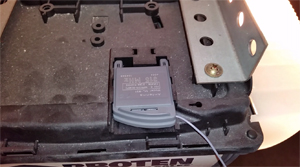3-17 Basic Slot Antenna and Its Complementary Dipole The slot antenna consists of a radiator formed by cutting a narrow slot in a large metal surface. Such an antenna is shown in figure 3-18. The slot length is a half wavelength at the desired frequency and the width is a small fraction of a wavelength.
- Antenna Theory Tutorial
- Antenna Basic Terms
- Types of Antennas
- Antenna Arrays
Basic Idea Of Slot Antenna Free
- Wave Propagation
- Antenna Theory Useful Resources
- Selected Reading
A person, who needs to convey a thought, an idea or a doubt, can do so by voice communication.
The following illustration shows two individuals communicating with each other. Here, communication takes place through sound waves. However, if two people want to communicate who are at longer distances, then we have to convert these sound waves into electromagnetic waves. The device, which converts the required information signal into electromagnetic waves, is known as an Antenna.
What is an Antenna ?

An Antenna is a transducer, which converts electrical power into electromagnetic waves and vice versa.
An Antenna can be used either as a transmitting antenna or a receiving antenna.
A transmitting antenna is one, which converts electrical signals into electromagnetic waves and radiates them.
A receiving antenna is one, which converts electromagnetic waves from the received beam into electrical signals.
In two-way communication, the same antenna can be used for both transmission and reception.
Antenna can also be termed as an Aerial. Plural of it is, antennae or antennas. Now-adays, antennas have undergone many changes, in accordance with their size and shape. There are many types of antennas depending upon their wide variety of applications.
Following pictures are examples of different types of Antennas.
In this chapter, you are going to learn the basic concepts of antenna, specifications and different types of antennas.
Need of Antenna
In the field of communication systems, whenever the need for wireless communication arises, there occurs the necessity of an antenna. Antenna has the capability of sending or receiving the electromagnetic waves for the sake of communication, where you cannot expect to lay down a wiring system. The following scenario explains this.
Slot Antenna Design
Scenario
In order to contact a remote area, the wiring has to be laid down throughout the whole route along the valleys, the mountains, the tedious paths, the tunnels etc., to reach the remote location. The evolution of wireless technology has made this whole process very simple. Antenna is the key element of this wireless technology.
In the above image, the antennas help the communication to be established in the whole area, including the valleys and mountains. This process would obviously be easier than laying a wiring system throughout the area.
Radiation Mechanism
The sole functionality of an antenna is power radiation or reception. Antenna (whether it transmits or receives or does both) can be connected to the circuitry at the station through a transmission line. The functioning of an antenna depends upon the radiation mechanism of a transmission line.
A conductor, which is designed to carry current over large distances with minimum losses, is termed as a transmission line. For example, a wire, which is connected to an antenna. A transmission line conducting current with uniform velocity, and the line being a straight one with infinite extent, radiates no power.
For a transmission line, to become a waveguide or to radiate power, has to be processed as such.
If the power has to be radiated, though the current conduction is with uniform velocity, the wire or transmission line should be bent, truncated or terminated.
If this transmission line has current, which accelerates or decelerates with a timevarying constant, then it radiates the power even though the wire is straight.
The device or tube, if bent or terminated to radiate energy, then it is called as waveguide. These are especially used for the microwave transmission or reception.
This can be well understood by observing the following diagram −
The above diagram represents a waveguide, which acts as an antenna. The power from the transmission line travels through the waveguide which has an aperture, to radiate the energy.
Basic Types of Antennas
Antennas may be divided into various types depending upon −
The physical structure of the antenna.
The frequency ranges of operation.
The mode of applications etc.
Physical structure
Following are the types of antennas according to the physical structure. You will learn about these antennas in later chapters.
- Wire antennas
- Aperture antennas
- Reflector antennas
- Lens antennas
- Micro strip antennas
- Array antennas

Frequency of operation
Following are the types of antennas according to the frequency of operation.
- Very Low Frequency (VLF)
- Low Frequency (LF)
- Medium Frequency (MF)
- High Frequency (HF)
- Very High Frequency (VHF)
- Ultra High Frequency (UHF)
- Super High Frequency (SHF)
- Micro wave
- Radio wave
Mode of Applications
Following are the types of antennas according to the modes of applications −

Antenna Design Basics
- Point-to-point communications
- Broadcasting applications
- Radar communications
- Satellite communications